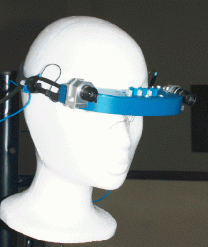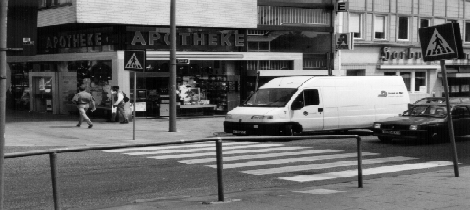
 Only one prototype of MOVIS exists. It consists of three seperate
parts:
Only one prototype of MOVIS exists. It consists of three seperate
parts:

The glasses, a spectacle like device, were build by Jurca Optoelektronik GmbH. They consist of two miniature cameras, one on each side of the head, and two headphones (these do not go directly into the ears, but can be afixed on the frame close to the ears, leaving the ears free to perform their vital function). In addition, three acceleration sensors are mounted atop the glasses, providing the glasse's (and therefore the head's) angles of roll and tilt.
 The cameras used are two miniature cameras made by teli.
The cameras measured 1.7cm by 5.5cm originally, but where
shortened to less than 5cm by
Jurca Optoelektronik GmbH,
the partner who build the glasses.
The cameras used are two miniature cameras made by teli.
The cameras measured 1.7cm by 5.5cm originally, but where
shortened to less than 5cm by
Jurca Optoelektronik GmbH,
the partner who build the glasses.
 They are
1-chip colour cameras with a chip measuring 6.4mm by 4.8mm. The
maximum resolution is 470 lines by 420 lines. However, since the
cameras supply interlaced images, only half the image can be used
each time, bringing the resolution down to something like 470
lines by 210 lines. The cameras use a 7.5mm lense made by Toshiba
which, unfortunately, shows considerable distortions. To give you
an idea what to expect from a 470 times 210 image, here is one
(without the nonlinear distortion).
They are
1-chip colour cameras with a chip measuring 6.4mm by 4.8mm. The
maximum resolution is 470 lines by 420 lines. However, since the
cameras supply interlaced images, only half the image can be used
each time, bringing the resolution down to something like 470
lines by 210 lines. The cameras use a 7.5mm lense made by Toshiba
which, unfortunately, shows considerable distortions. To give you
an idea what to expect from a 470 times 210 image, here is one
(without the nonlinear distortion).
Mounted atop the camera are three acceleration sensors. These are used to measure the cameras angles' of roll and tilt relative to some initial starting position. This can for example be used to identify the maximum extend of regions within the camera-image containing e.g. zebra-crossings. It can also be used to veriefy the pose of possible objects, and for several other purposes.
However, this is a rather new addition to the glasses and hasn't been fully integrated nor tested yet.
the headphones used for the MOVIS prototype are standard consumer headphones, similar or identical to the ones people are using for their walkman. They do not insert directly into the ear, but are mounted close to it. This allows the blind user to retain his full aural abilities while using MOVIS.
the pouch currently contains the electronic for the cameras, the user-interface (basically a keypad) as well as the batteries. It measures approximately 30cm by 23cm by 12cm. However, currently it contains mostly empty space. The aim